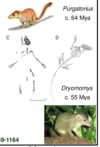Lecture 3- Primate evolution and diversity I Flashcards
(42 cards)
What does primate mean?
- first rank
- primates viewed as the highest rank, the name taken from how we refer to heads of churches and archbishops
- controversial nomenclature as Linnaeus identified similarities between monkeys and humans and has hence classified them together
What does classification mean?
- groups organisms together into phyla, class, order, genus etc based on shared characteristics.
- e.g.: all bats have wings, all mammals produce milk
- knowing that bats have wings and the ancestor didn’t gives us little information as to where the split occured

What does phylogeny mean?
- represents the evolutionary relationships between organisms (it’s an evolutionary tree), based on shared derived characteristics (synapomorphies).
- Shared primitive characteristics (symplesiomorphies) are not considered useful
What are symplesiomorphies?
-shared derived characteristics on which a phylogenic tree is based
What are symplesiomorphies?
-shared primitive characteristics, not considered useful for establishing a phylogenic tree
What is this?

- the mammalian evolutionary tree
- primates are a small portion of the tree (red rectangle)
What are the nearest relatives of primates?
-flying Lemurs (Dermoptera)
What are the Euarchonta?
- means true ancestors, these are three groups that share a common ancestor from which humans have also eveolved
- the groups are:
1. Dermoptera (Flying Lemurs)
2. Primates
3. Scandentia (Tree shrews)= proposed basal link to primates, separated approx. 80 MYA

How old are the earliest primate fossils, where were they found and what were the characteristics of those animals?
- 65-55 MY
- most found in America but also found in Asia and Africa (spread quickly)
- belonged to a now extinct group known as Plesiadapiformes
- small 20-30g, arboreal, insectivorous
- similar in appearance and habits to modern tree shrews -found two species:
1. Purgatorius (c. 64 MYO) - maybe the basal link of primates?
2. Dryomomys (c. 55 MYO) - maybe the ancestor of tree shrews and the basal link?

What are the characteristics of primates in general? (9)
- Grasping hands and feet
- Opposable digits
- Finger nails (instead of claws)
- Hind limb-dominated locomotion (arms less strong)
- Reduced sense of smell (small noses
- Binocular vision
- Extended maternal care
- Large brains
- Relatively small number of teeth
What are the three primate characteristics that are related to arboreal living?
- Grasping hands and feet
- Opposable digits
- Binocular vision
What is this?

- comprehensive primate phylogeny
- 1st split: Plesiadaformes splitting into Strepsirrhines and Haplorrhines
- 2nd split: Haplorrhines split into Anthropoidea and Tarsiiformes (tarsiers)
- 3rd split: Anthropoidea split into Platyrrhines (New World Monkeys) and Catarrhines (Old World Monkeys)
- 4th split: Catarrhines split into Hominoidea and Cercopithecoidea
What was the first split in primate evolution?
- the Plesiadaformes split into Strepsirrhines and Haplorrhines
- this occured approx 78-63 MYA

How many species of Strepsirrhines are there and where do they occur?
- 110 species (about a quater of primate species)
- mostly in Madagascar, few in S Africa, SE Asia
How many species of Haplorrhines are there and where do they occur?
- 280 species
- spread throughout the world, in Africa, Asia, America
In which areas are there differences between Strepsirrhines and Haplorrhines?
- Nose
- Eyes
- Snout
- Teeth
- Hand
How is the nose different in Strepsirrhines and Haplorrhines?
- Strepsirrhines: wet nose, nose pad (rhinarium) and nose slits
- Haplorrhines: dry nose, no nose pad and have nostrils
- Strepsirrhines have better sense of smell & use scent- marking, possibly associated with nocturnal existence

How are the eyes different in Strepsirrhines and Haplorrhines?
Strepsirrhines:
- the back of the retina has a layer (the tapetum) that reflects light which allows for more light to be collected at the retina
- this is believed to be a nocturnal adaptation (increases light gathering abilities of the rod cells)
- mostly dichromatic (not colour vision)
Haplorrhines:
-have colour vision and no tapetum, poorer visual acuity in the dark (as they are diurnal)

How is the snout different in Strepsirrhines and Haplorrhines?
Strepsirrhines:
- have larger snout and a better sense of smell
Haplorrhines:
- have a flatter profile and less prominent snouts

How are teeth different in Strepsirrhines and Haplorrhines?
Strepsirrhines:
- incisors and canines modified into thin prominent teeth = toothcomb which is used for grooming and chewing off bark
Haplorrhines:
-comparable mammalian dentition

How are hands different in Strepsirrhines and Haplorrhines?
Strepsirrhines:
- second digit is modified into a longer claw, used for grooming.
eg. Aye-ayes (Daubentonia madagascariensis) have extra long claw for food extraction (eat insect grubs)
Haplorrhines:
-“normal” hands

What were the key changes in the evolution of Haplorrhines? (4)
- Reduced sense of smell
- Development of trichromatic vision
- Tendency to greater frugivory
- Loss of ability to synthesise Vit C
- Single GLO gene mutation that only codes for Vitamin C (this means the mutation only affects vit C and is otherwise non-detrimental, our ancestors survived thanks to having a high fruit content in their diet)
What are some of the species that have lost the ability to synthesise Vitamin C and how do they survive?
-selection on the gene is neutral
- Species that have lost Vit C = High dietary vitamin C content (fruit usually)
- Human RDA approx 1 mg/kg/day
- Gorillas (20-30 mg/kg/day)
- Howler monkeys (88 mg/kg/day)
- Spider monkeys (106 mg/kg/day)
What is the controversial fossil of a possible early Haplorrhine?
-Darwinius masillae (aka “Ida”)
- Most complete fossil primate ever found
- 47 Mya old - found in Germany
- Lacks toothcomb and second-digit claw (hence Haplorrhine)
- 60cm long - probably 600-900g
- Diet - frugivorous/herbivorous (Fur and stomach contents preserved)
- controversial as the line is there and the time between the find and publishing (1983-2009)
- some say it is a lemur but doesn’t have the basic characteristics!
- probably spread from Siberia then to Europe and then east to the Americas













